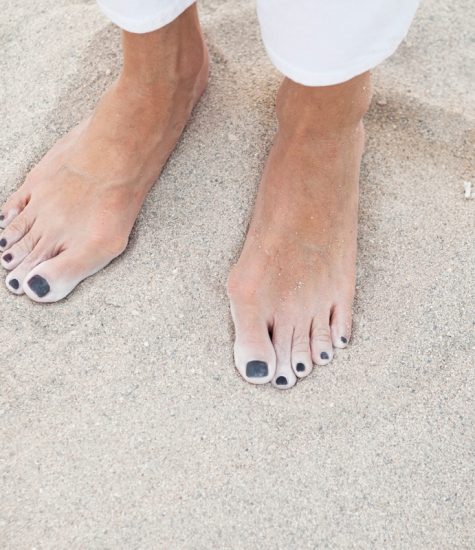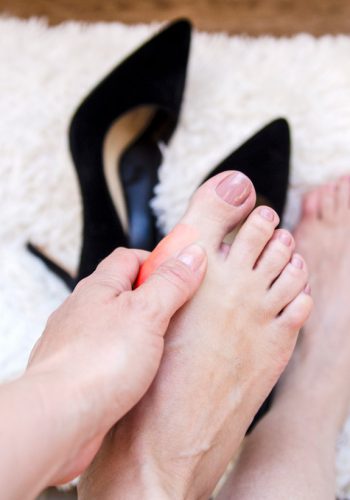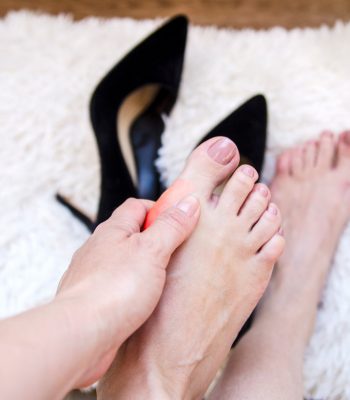What Is a Bunion?
A bunion is an enlargement of the joint at the base of the big toe—the metatarsophalangeal (MTP) joint—that forms when the bone or tissue at the big toe joint moves out of place. This forces the toe to bend toward the others, causing an often painful lump of bone on the foot. Since this joint carries a lot of the body’s weight while walking, bunions can cause extreme pain if left untreated. The MTP joint itself may become stiff and sore, making even the wearing of shoes difficult or impossible. Bunions– from the Latin “bunio,” meaning enlargement–can also occur on the outside of the foot along the little toe, where it is called a “bunionette” or “tailor’s bunion.”
Symptoms
- Development of a firm bump on the outside edge of the foot, at the base of the big toe
- Redness, swelling, or pain at or near the MTP joint
- Corns or other irritations caused by the overlap of the first and second toes
- Restricted or painful motion of the big toe

What Is a Bunion?
A bunion is an enlargement of the joint at the base of the big toe—the metatarsophalangeal (MTP) joint—that forms when the bone or tissue at the big toe joint moves out of place. This forces the toe to bend toward the others, causing an often painful lump of bone on the foot. Since this joint carries a lot of the body’s weight while walking, bunions can cause extreme pain if left untreated. The MTP joint itself may become stiff and sore, making even the wearing of shoes difficult or impossible. Bunions– from the Latin “bunio,” meaning enlargement–can also occur on the outside of the foot along the little toe, where it is called a “bunionette” or “tailor’s bunion.”
Symptoms
- Development of a firm bump on the outside edge of the foot, at the base of the big toe
- Redness, swelling, or pain at or near the MTP joint
- Corns or other irritations caused by the overlap of the first and second toes
- Restricted or painful motion of the big toe

How Do You Get a Bunion?
Bunions form when the normal balance of forces that is exerted on the joints and tendons of the foot becomes disrupted. This can lead to instability in the joint and cause deformity. They are brought about by years of abnormal motion and pressure over the MTP joint. They are, therefore, a symptom of faulty foot development and are usually caused by the way we walk, and our inherited foot type, our shoes, or other sources.
Although bunions tend to run in families, it is the foot type that is passed down—not the bunion. Parents who suffer from poor foot mechanics can pass their problematic foot type on to their children, who, in turn, are also prone to developing bunions. The abnormal functioning caused by this faulty foot development can lead to pressure being exerted on and within the foot, often resulting in bone and joint deformities such as bunions and hammertoes.
Other causes of bunions are foot injuries, neuromuscular disorders, or congenital deformities. People who suffer from flat feet or low arches are also prone to developing these problems, as are arthritic patients and those with inflammatory joint disease. Occupations that place undue stress on the feet are also a factor; ballet dancers, for instance, often develop the condition.
Wearing shoes that are too tight or cause the toes to be squeezed together is also a common factor, one that explains the high prevalence of the disorder among women.
What Can You Do For Relief?
- Apply a commercial, nonmedicated bunion pad around the bony prominence
- Wear shoes with a wide and deep toe box
- If your bunion becomes inflamed and painful, apply ice packs several times a day to reduce swelling
- Avoid high-heeled shoes over two inches tall
- See your podiatric physician if pain persists
How Do You Get a Bunion?
Bunions form when the normal balance of forces that is exerted on the joints and tendons of the foot becomes disrupted. This can lead to instability in the joint and cause deformity. They are brought about by years of abnormal motion and pressure over the MTP joint. They are, therefore, a symptom of faulty foot development and are usually caused by the way we walk, and our inherited foot type, our shoes, or other sources.
Although bunions tend to run in families, it is the foot type that is passed down—not the bunion. Parents who suffer from poor foot mechanics can pass their problematic foot type on to their children, who, in turn, are also prone to developing bunions. The abnormal functioning caused by this faulty foot development can lead to pressure being exerted on and within the foot, often resulting in bone and joint deformities such as bunions and hammertoes.
Other causes of bunions are foot injuries, neuromuscular disorders, or congenital deformities. People who suffer from flat feet or low arches are also prone to developing these problems, as are arthritic patients and those with inflammatory joint disease. Occupations that place undue stress on the feet are also a factor; ballet dancers, for instance, often develop the condition.
Wearing shoes that are too tight or cause the toes to be squeezed together is also a common factor, one that explains the high prevalence of the disorder among women.
What Can You Do For Relief?
- Apply a commercial, nonmedicated bunion pad around the bony prominence
- Wear shoes with a wide and deep toe box
- If your bunion becomes inflamed and painful, apply ice packs several times a day to reduce swelling
- Avoid high-heeled shoes over two inches tall
- See your podiatric physician if pain persists
Conservative Treatment For Bunion Pain
Treatment options vary with the type and severity of each bunion, although identifying the deformity early in its development is important in avoiding surgery. Podiatric medical attention should be sought at the first indication of pain or discomfort because left untreated, bunions tend to get larger and more painful, making a nonsurgical treatment less of an option.
The primary goal of most early treatment options is to relieve pressure on the bunion and halt the progression of the joint deformity. A podiatric physician may recommend these treatments:
Padding & Taping
Often the first step in a treatment plan, padding the bunion minimizes pain and allows the patient to continue a normal, active life. Taping helps keep the foot in a normal position, thus reducing stress and pain.
Medication
Anti-inflammatory drugs and cortisone injections are often prescribed to ease the acute pain and inflammations caused by joint deformities.
Physical Therapy
Often used to provide relief of the inflammation and from bunion pain. Ultrasound therapy is a popular technique for treating bunions and their associated soft tissue involvement.
Orthotics
Shoe inserts may be useful in controlling foot function and may reduce symptoms and prevent worsening of the deformity. When early treatments fail or the bunion progresses past the threshold for such options, podiatric surgery may become necessary to relieve pressure and repair the toe joint.
Surgical Options
Several surgical procedures are available to the podiatric physician The surgery will remove the bony enlargement, restore the normal alignment of the toe joint, and relieve pain.
A simple bunionectomy, in which only the bony prominence is removed, may be used for the less severe deformity. Severe bunions may require a more involved procedure, which includes cutting the bone and realigning the joint.
Recuperation takes time, and swelling and some discomfort are common for several weeks following surgery. Pain, however, is easily managed with medications prescribed by your podiatric physician.
Conservative Treatment For Bunion Pain
Treatment options vary with the type and severity of each bunion, although identifying the deformity early in its development is important in avoiding surgery. Podiatric medical attention should be sought at the first indication of pain or discomfort because left untreated, bunions tend to get larger and more painful, making a nonsurgical treatment less of an option.
The primary goal of most early treatment options is to relieve pressure on the bunion and halt the progression of the joint deformity. A podiatric physician may recommend these treatments:
Padding & Taping
Often the first step in a treatment plan, padding the bunion minimizes pain and allows the patient to continue a normal, active life. Taping helps keep the foot in a normal position, thus reducing stress and pain.
Medication
Anti-inflammatory drugs and cortisone injections are often prescribed to ease the acute pain and inflammations caused by joint deformities.
Physical Therapy
Often used to provide relief of the inflammation and from bunion pain. Ultrasound therapy is a popular technique for treating bunions and their associated soft tissue involvement.
Orthotics
Shoe inserts may be useful in controlling foot function and may reduce symptoms and prevent worsening of the deformity. When early treatments fail or the bunion progresses past the threshold for such options, podiatric surgery may become necessary to relieve pressure and repair the toe joint.
Surgical Options
Several surgical procedures are available to the podiatric physician The surgery will remove the bony enlargement, restore the normal alignment of the toe joint, and relieve pain.
A simple bunionectomy, in which only the bony prominence is removed, may be used for the less severe deformity. Severe bunions may require a more involved procedure, which includes cutting the bone and realigning the joint.
Recuperation takes time, and swelling and some discomfort are common for several weeks following surgery. Pain, however, is easily managed with medications prescribed by your podiatric physician.

Bunion Tips
- Wear comfortable shoes that conform to the shape of your foot
- Wear shoes with a wide and deep toe box
- Always fit the larger foot and have your feet sized each time you purchase shoes
- Apply a commercial, nonmedicated bunion pad around the bony prominence
- If your bunion becomes inflamed and painful, apply ice packs several times a day to reduce swelling
- Avoid high-heeled shoes over two inches tall
- Seek professional podiatric evaluation and assistance with uncomfortable or noticeable bunions
Your podiatric physician/surgeon has been trained specifically and extensively in the diagnosis and treatment of all manners of foot conditions. This training encompasses all of the intricately related systems and structures of the foot and lower leg including neurological, circulatory, skin, and the musculoskeletal system, which includes bones, joints, ligaments, tendons, muscles, and nerves.
Bunion Tips
- Wear comfortable shoes that conform to the shape of your foot
- Wear shoes with a wide and deep toe box
- Always fit the larger foot and have your feet sized each time you purchase shoes
- Apply a commercial, nonmedicated bunion pad around the bony prominence
- If your bunion becomes inflamed and painful, apply ice packs several times a day to reduce swelling
- Avoid high-heeled shoes over two inches tall
- Seek professional podiatric evaluation and assistance with uncomfortable or noticeable bunions
Your podiatric physician/surgeon has been trained specifically and extensively in the diagnosis and treatment of all manners of foot conditions. This training encompasses all of the intricately related systems and structures of the foot and lower leg including neurological, circulatory, skin, and the musculoskeletal system, which includes bones, joints, ligaments, tendons, muscles, and nerves.

